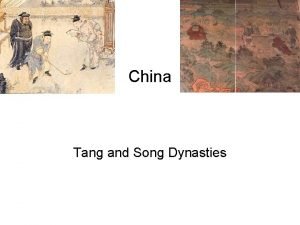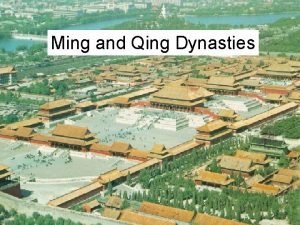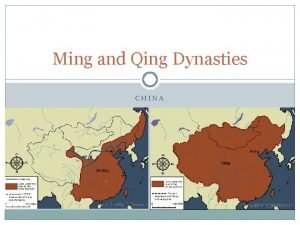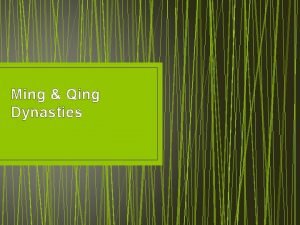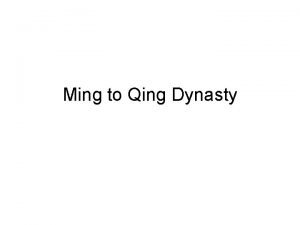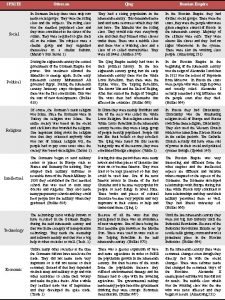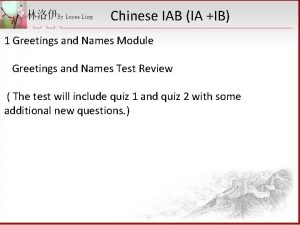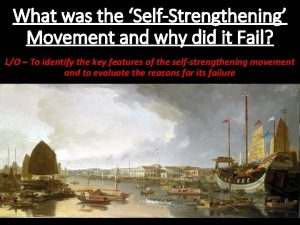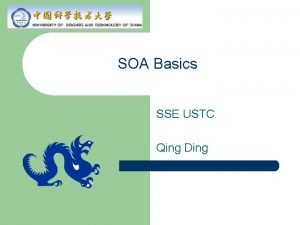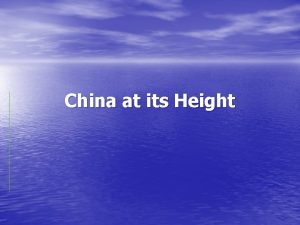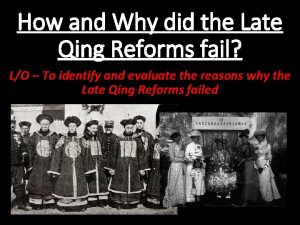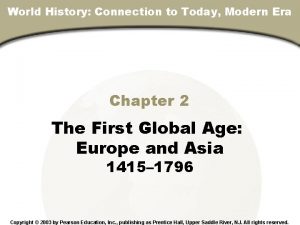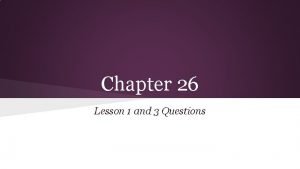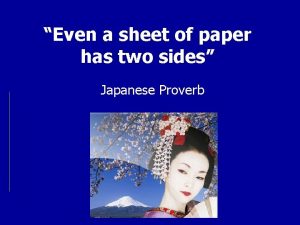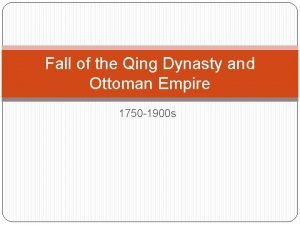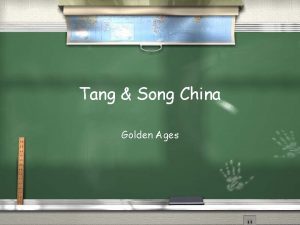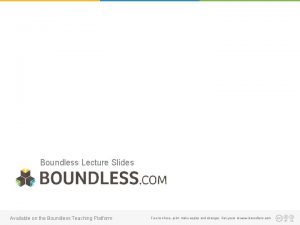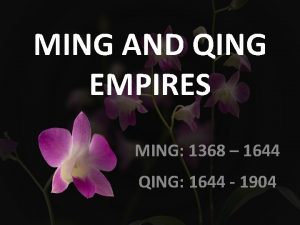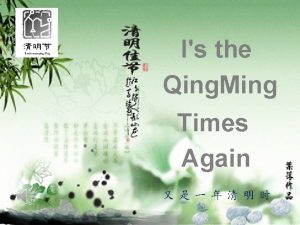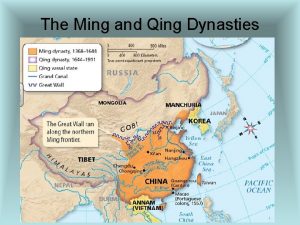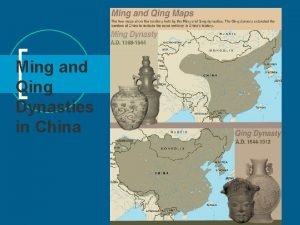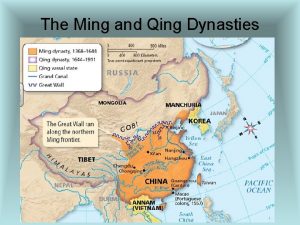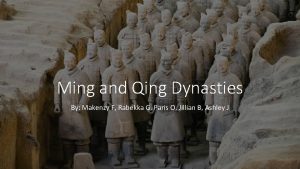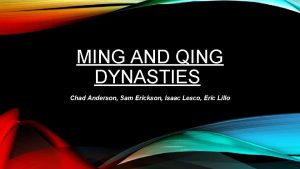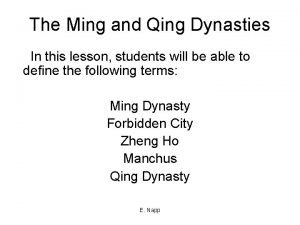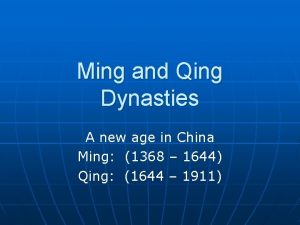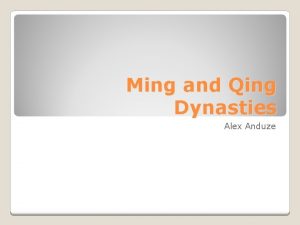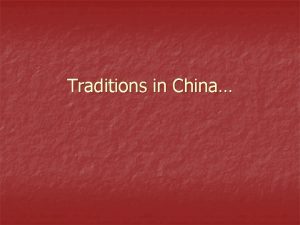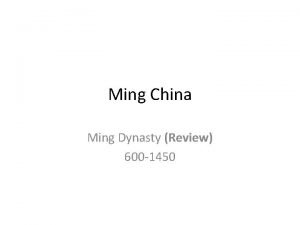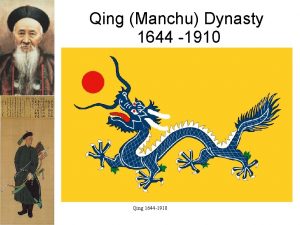End of the Dynasties Ming to Qing The
























- Slides: 24

End of the Dynasties Ming to Qing

The Ming Dynasty was founded by Yuanzhang, the son of a poor peasant, who allied himself with the rebellious scholar-gentry class and ended the weakening Yuan Dynasty (the Mongols). He took the name of Ming Hongwu and set about reforming the country. He: abolished slavery initiated land reform strengthened the power government. of the central Ming Dynasty (1368 – 1644)


After Hongwu’s death, his son, Yongle, carried on his father’s strong centralized governmental system. Yongle: moved the capital to Beijing restored Chinese rule over Vietnam sponsored a series of naval voyages took Chinese ships as far as Africa. that The voyages were later stopped by the entrenched bureaucracy. They felt it was a danger to their power. The commander of the fleet, Zheng He, was forbidden to sail again. China turned inward. Ming Expansion and Exploration






v Spurred on by the stories of Marco Polo, and the riches of the Silk Road, Europeans sought the shores of China for trade. Portugal was the first to land in China in 1514. v By the time the Portuguese landed in China, Ming China was at its peak of power. Their government, run by a strong, educated bureaucracy, was highly efficient. v The Portuguese, however, were crude and illmannered and they were quickly kicked out of China and only allowed to trade through the territory of Macao.

Along with the Portuguese came Jesuit missionaries. The Jesuits were highly educated and brought along new inventions such as the clock to impress the Chinese. Both sides were impressed with the other and reports back to Europe only made the Europeans more eager to interact with China.

v Like all empires, the Ming fell into decline. A series of weak rulers encouraged corruption and the vast flow of European silver into China for Chinese products caused inflation. v High taxes combined with poor harvests led to peasant unrest and riots in the cities. On the northern border, the Chinese were in conflict with northern tribes. v Li Zicheng, a fired postal worker, led a revolt and occupied Beijing. The emperor, left without an escape route, committed suicide. v The fall of the dynasty created an opening that was quickly filled by the Manchus, a northern tribe. Li Zicheng was defeated and a new dynasty created: the Qing (Manchu).

v The Manchus quickly consolidated power. They forced all Chinese men to shave their foreheads and braid their hair in a queue. The Manchus also kept the Chinese out of the top government positions. v Despite resentment from the Chinese people, the Manchus brought peace and political stability to China. v Two emperors, Kangxi and Qianlong, ruled for over a hundred years. Kangxi is considered by many Chinese to have been China’s greatest ruler. He kept China’s borders secure, supported the arts, and gained the respect of the bureaucracy.



During the reign of Kangxi, the influence of Christian missionaries reached their height. Qianlong was also an able ruler who kept China at its height of power– at least at first.

The Qing maintained the Ming political system with a few changes. The Manchus, who made up 2% of the population, were legally defined as a separate group. The Manchus shared power with the Han Chinese under the diarchy system. In this system, the Manchus held all the important posts with the Chinese holding the rest. The Manchus also continued endorsing Confucianism as the state ideology.

The first signs of decline came in the last years of Qianlong’s rule. He embarked on expensive military campaigns and came under the influence of corrupt bureaucrats. High taxes and corruption caused peasant unrest in central China resulting in the White Lotus Rebellion (1796 -1804). The rebellion was suppressed but it was clear China’s glory days were over. This decline also coincided with the arrival of ever greater numbers of Europeans intent on trade.


Conflict with foreigners began with Russian fur traders in the north. It ended in a treaty that gave Mongolia to China but gave Russia permanent trade status in Beijing. By the beginning of the 1700’s, Britain had replaced Portugal as the dominant trading force on China’s coast. Operating through the East India Company, the British established a trading post in Canton. The Chinese attempted to limit British influence by confining it to a small island to a set period of time. The British protested and tried to negotiate a freer trade status but the emperor declined saying, “China had no need of British manufactures. ”


1. The Ming dynasty was founded after the fall of the Yuan (Mongol) Dynasty 2. Zhenghe was noted for His great voyages 3. What caused the great sea voyages to stop? The bureaucrats feared they would lose power 4. The first Europeans to land in China were The Portuguese 5. Where were the Portuguese restricted to? Macao

6. How did Jesuit missionaries impress the Chinese? Inventions and technology 7. Who was Li Zicheng? A fired postal worker who overthrew the Ming Emperor 8. What dynasty took over from the Ming? The Qing or Manchu 9. How did the Manchu “mark” the Han Chinese? It forced them to shave their foreheads and wear a queue 10. Who was the greatest Chinese ruler? Kangxi

11. What system had Manchus and Chinese sharing power? Diarchy 12. What state was the first to come into conflict with the Manchu? Russia 13. Where were British traders allowed to set up business? Canton 14. What peasant rebellion highlighted the decline of the Manchus? White Lotus Rebellion
 Qing qing hardware contacts
Qing qing hardware contacts Tang vs song dynasty venn diagram
Tang vs song dynasty venn diagram Qing conquest of the ming
Qing conquest of the ming Ming empire
Ming empire Mingoch
Mingoch Rise of the qing dynasty
Rise of the qing dynasty Qing dynasty dbq
Qing dynasty dbq Qing dynasty social classes
Qing dynasty social classes The wing dynasty menu
The wing dynasty menu Qing wen nin gui xing
Qing wen nin gui xing Self-strengthening movement
Self-strengthening movement Soa basics
Soa basics Decline of qing dynasty
Decline of qing dynasty Height of the qing dynasty
Height of the qing dynasty China at its height
China at its height Late qing reform
Late qing reform What policy did the qing adopt regarding foreign trade?
What policy did the qing adopt regarding foreign trade? Chapter 26 lesson 1 the decline of the qing dynasty
Chapter 26 lesson 1 the decline of the qing dynasty Paper has 6 sides
Paper has 6 sides The rise and fall of qing dynasty
The rise and fall of qing dynasty Achievements of the tang and song dynasties
Achievements of the tang and song dynasties Golden age of tang and song dynasties
Golden age of tang and song dynasties Shang dynasty acrostic poem
Shang dynasty acrostic poem How did the sui and tang dynasties reunite china
How did the sui and tang dynasties reunite china Shang dynasty
Shang dynasty

